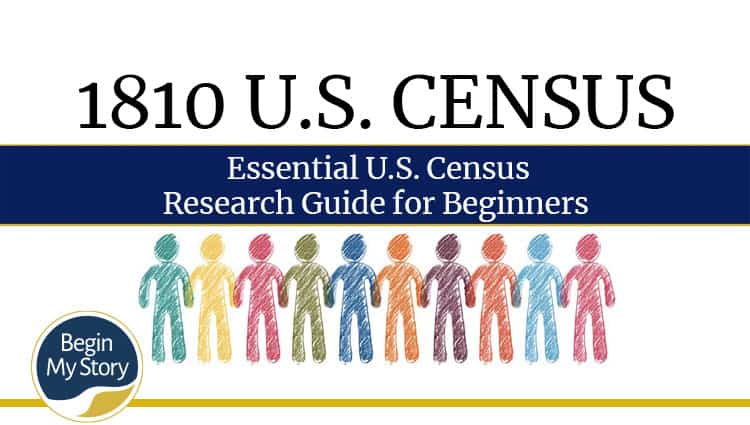
Use the 1810 U.S. Census Research Guide for detailed ancestry research.
This is an essential guide for researching the 1810 U.S. Census. The 1810 U.S. Census is a list of questions asked to the U.S. Federal Population in 1810. The census captures the moment in time for each person recorded in the 1810 Census.
Use this guide to learn about and discover the stories of the people who lived during and before the 1810s. With the 1810 U.S. census information, you can, for starters, build individual and family profiles, write narratives, build family trees and find related records to research.
Table of Contents
ToggleTable of Contents for 1810 U.S. Census Guide
The Essential 1810 U.S. Census Research Guide contains the following sections:
- Additional 1790-1950 U.S. Federal Census Resources
- Details about the 1810 U.S. Census
- How to Search and Use the 1810 U.S. Census Data
- How 1810 U.S. Census Can Lead to Military Records
- Use the 1810 U.S. Census to Calculate the Birth Year
- What is the 1810 U.S. Federal Census?
- What Can You Find in U.S. Census
- Questions Asked in the 1810 U.S. Census
- Author B. Schreiber’s Introduction to the U.S. Census
Note: All images in this guide reflect life from the 1810s.
Why use the Essential 1810 U.S. Census Research Guide for Beginners
This guide is based on 1,000s of hours of my first-hand experience in researching the U.S. Censuses for purposes related to writing individuals and family narratives, family history, and genealogy. Writers, family historians, and genealogists can, for example, use this comprehensive research guide to:
- Learn 100’s of census research tips and tricks
- Correctly connect related individuals and family
- Complete and extend ancestral family trees
- Recognize, decipher and use clues from census data
- Build and expand individual family profiles
- Learn about and find other historical records
- Conduct exhaustive background research for writing narratives
- Write compelling individual and family narratives
- Find local, regional, state and national record repositories
Why the Essential 1810 U.S. Census Research Guide for Beginners was written
I’m Author B. Schreiber, a professional writer and blogger. I first started researching the U.S. Censuses to gain background information for stories and narratives I was writing about individuals and families I was related to.
Researching the U.S. Censuses can be complex and overwhelming. I spend hundreds of hours learning about each census and how to solve my research problems. This 1810 U.S. Census Research Guide is a compilation of what I learned and continue to apply. I am sharing this information because I understand how frustrating U.S. Census research can be. Perhaps this knowledge can help you. See the section: Author B. Schreiber’s Introduction to the U.S. Census.
Additional 1790-1950 U.S. Federal Census Resources
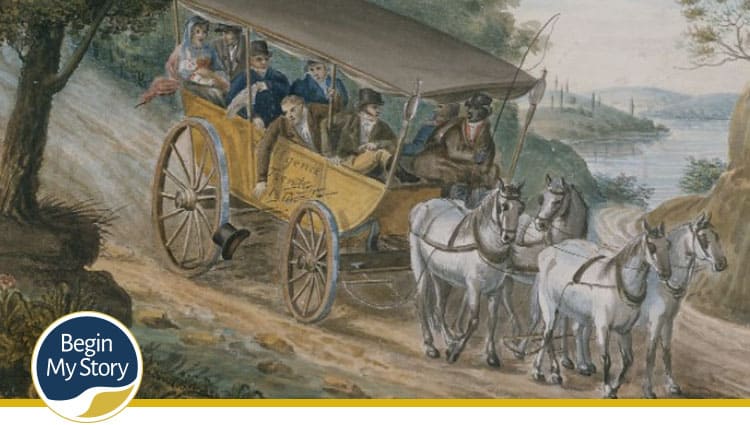
Essential censuses research guides
Click on any of the following years, and you will be taken to that years’ essential census research guide:
Census and historical record research articles
Throughout this U.S. federal census guide, please find links to resources that I have specifically prepared to help you. In addition, I have written and assembled other resources to provide you with a more in-depth understanding of the census research process. I have tried to cover every possible question and angle you are likely to face in your U.S. census research. I would encourage you to use the resources often. The resources include:
- 35 Important U.S. Census Research Tips and Tricks
- Pre-1850 U.S. Census Research Tips for Historians
- Where to find 1850-1940 Censuses Research Clues
- Introduction to 1790-1940 U.S. Censuses Ancestry Research
- How to Use Naming Patterns in Ancestry Research
- 5 Step Ancestry Research Process for Historians
- How to Cite and Verify Ancestry Research
- How to Conduct Detailed Exhaustive Historical Research
- Introduction to Ancestry Research and Historical Records
- 15 Strategies to Find Ancestor Names in Historical Records
- Keep Ancestry Research Focused with These 28 Simple Tips
(Video) Introduction to 1810 U.S. Census Historical Research. The “Introduction to 1810 U.S. Census Historical Research” provides a quick overview of the 1810 U.S. Census and how you can make the most from the 1810 U.S. Census for individual and family historical and narrative research.
For additional videos, see the BeginMyStory YouTube Channel.
Where to find the 1810 U.S. Census online
The following are some standard resources I have consulted:
Details about the 1810 U.S. Census
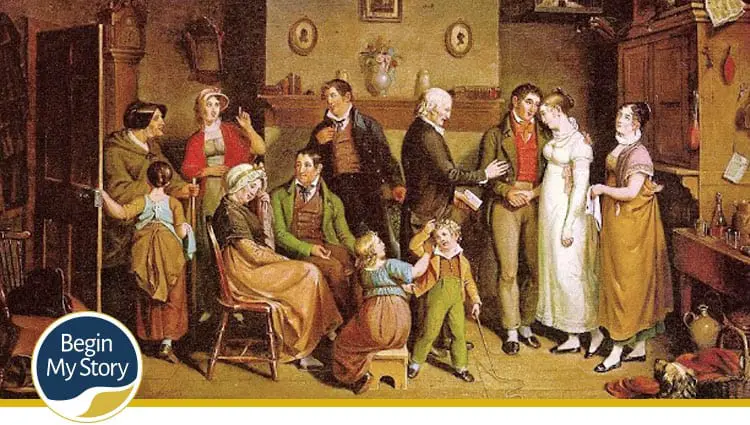
The following are a few of the details that are important to understand about the 1810 U.S. Federal census:
Number of persons included in the 1810 U.S. Census: 7,239,881 people lived in the United States, of whom 1,191,362 were slaves.
1810 U.S. Census day: August 6, 1810
1810 U.S. Census duration: 10 months
1810 U.S. Census geography:
- States and territories enumerated: 17 states and six territories were included in the census.
- New states: The newest state that included the 1810 U.S. Census was Ohio.
- Territories included: Illinois, Indiana (inc. Michigan), Louisiana, Mississippi, Ohio, Orleans
- The available states include: Connecticut, Delaware, Kentucky, Maine (part of Massachusetts), Maryland, Massachusetts, New Hampshire, New York, North Carolina, Pennsylvania, Rhode Island, South Carolina, Tennessee (Grainger and Rutherford counties only), Vermont, Virginia (incl. present-day West Virginia)
- The missing states: District of Columbia, Georgia, New Jersey, Tennessee (except Grainger Rutherford counties), territories of Indiana, Michigan, and Mississippi, and partial losses in the territories of Illinois (Randolph is extant, St. Clair is lost) and Ohio (all lost except Washington County)
- Efforts to reproduce missing states: There are ongoing efforts to reproduce the 1810 U.S. Census for the missing states by using local county records such as tax lists, oaths of allegiance, land entities, militia lists, petitions, road records, and other sources. These types of records are also known as census substitutes.
A few interesting facts about the 1810 U.S. Census include:
U.S. President. The president was James Madison.
Manufacturing question
This was the first census where questions were asked about manufacturing. Few of the schedules have survived. If the manufacturing schedules exist, look at the end of the county or district on the microfilm/images.
- Enumerators did not receive instructions on how the manufacturing schedules were drawn or what questions to ask. For example, in some states, some or all of the following were enumerated: gristmills; cotton machines; hatters shops and a number of hats; saddlers shops and number of saddles; the number of looms, linen manufactured and a number of yards, woolen manufactured and a number of yards; Stills and number of gallons; and blacksmith shops.
- In later censuses, the Federal government would add questions regarding agriculture, mining, governments, religious groups, business, housing, and transportation.
No preprinted forms
1790-1820 censuses did not have preprinted forms for the census takers to record information. Each census taker was given sample copies and expected to copy his census return on whatever paper he could find and post it in two public places.
Public hearing
1790-1840 censuses were public, meaning they were posted publicly so those included on the census could read, view and catch omissions and errors.
Age brackets
Age brackets are split into five groups. Only whites, the number of slaves are recorded, and Indians that were not taxed were included.
Published census
The 1810 U.S. Census published a 180-page volume.
- Information for the population was presented by counties and towns in northern states and Ohio, Kentucky, and Georgia.
- New York was presented by counties only.
- Southern states were presented by county.
- Counties and towns presented the territories.
Louisiana Territory
The Louisiana Territory was renamed the Missouri Territory in 1812. The Territory of Louisiana is purchased from France for a cost of 15 million dollars in 1803. The purchase includes all of present-day Arkansas, Iowa, Kansas, Missouri, Nebraska, Oklahoma, and part of the states of Colorado, Louisiana, Minnesota, Montana, New Mexico, North Dakota, South Dakota, and Wyoming.
How to Search and Use the 1810 U.S. Census Data
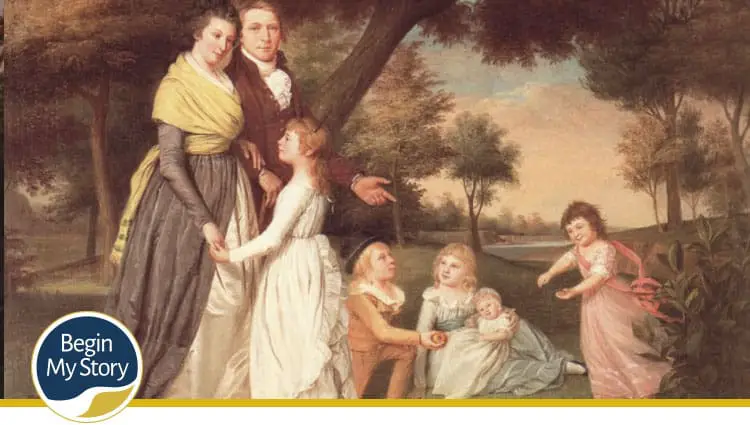
Learn how to search and use the data found in the 1810 U.S. Census. Too often, I have seen researchers overlooking the value of the 1810 U.S. Census because they believe the limited information cannot be effectively used. Yes, information is limited; however, in this section of the Essential 1810 U.S. Census Research Guide for Beginners, you are provided a review of research insights, tips and tricks, and must-know information to aid your research.
Table of Contents for 1810 U.S. Census Insights
The following is a list of the 1810 U.S. Census research insights. Each category provides research insights.
- Build A Family Profile
- Build A Case for Your Family Tree
- Head of Household Only Name Given
- How to Find Names of Women
- When A Woman Is Listed As Head of Household
- Age and Family Composition
- Slaves and Free African Americans
- Native Americans
- Follow the Neighbors
- Search All the Same Surnames
- Misspelled Names and Surnames Are OK
- Searching Online Databases
- Soundex Search
- First and Middle Names
- Search the Location
- Other Records Created During the 1810s
- What to Search After the 1810 U.S. Census
- Search the Original Record
- Research the State Censuses
Each of the following categories will provide you with some essential research insights, tips and tricks, and more for the 1810 U.S. Census.
Build A Family Profile
I make it practice to start with the information I already know or suspect about the family. I refer to this as my family profile. The more you know, the more options you have of correctly identifying and connecting the family from one generation to the next. The information I like to include in my profile include:
- Names of known and suspect family members
- Relationships of known and suspect family members
o Father (i.e., fathers, step-fathers)
o Mother (i.e., mothers, step-mothers)
o Children (i.e., brothers, sisters, step-children, adoptions)
o Brothers’/sisters’ –in-law and their spouses (i.e., persons married to grown children of the family)
o Grandparents (i.e., fathers’ side, mothers’ side, step-parent’s side)
o Siblings of parents and their families (i.e., fathers’ side, mothers’ side, step-parent’s side and the members of their households)
o Neighbors (i.e., names, surnames and family members)
o Group (i.e., this could be members of the organization, church, etc.)
o Borders (i.e., persons living in the household but not family members)
o Servants/slaves (i.e., persons who are identified as servants/slaves) - List of surname and variations
- Locations of where known and suspect family members (i.e., towns, regions, states)
- Locations of known and variations of the family surname (i.e., towns, regions, states)
- List of documents I already have organized in a timeline format
I realize this might be hard for the 1810 U.S. Census, but it is possible to include names that you have found on documents such as wills, court documents, church records and so forth. Having an idea of counts can give you ideas for sorting out the number tallies given in the free male, free female, free others, and slave columns.
Having a portion of the above-listed data will give you critical data that you can use when searching online databases, microfilm and other resources.
Build A Case for Your Family Tree
The most important counsel I can give when using the 1790-1840 censuses is not to make any assumptions based on the data you find, such as how big the family is by age and sex. Use the information you find to build a case and then  use other records to confirm and disprove what think is being presented about the family. Never run with your assumptions until they can be proved. I spent several years searching out someone else’s family unit that was not confirmed from the census data on 1790-the 1810s. Of course, it was my fault that I didn’t confirm the data before I started extending the research. Remember the data is based on all persons located in the home. For example,
use other records to confirm and disprove what think is being presented about the family. Never run with your assumptions until they can be proved. I spent several years searching out someone else’s family unit that was not confirmed from the census data on 1790-the 1810s. Of course, it was my fault that I didn’t confirm the data before I started extending the research. Remember the data is based on all persons located in the home. For example,
Please don’t assume that the head of the household is the oldest male, although it usually is.
Don’t assume, the oldest female is the wife of the head of the household. It could be a friend, neighbor, widowed sister or grandmother. It could even be a male who lost his wife, and the females are his children.
Don’t assume that the head of the household is the first and only spouse. Are there different age groups for children? This could mean the man married a younger wife and had children, married another woman and merged two-family units, or even could be the male is taken care of deceased relative’s family.
Don’t assume that all the children in the home belong to the head of the household. The children could be his siblings who are now living with him after the death of his parents or children of a brother or sister. The children could be friends who are away and happen to be in their home when the census was taken.
Head of Household Only Name Given
The head of household is the only name given. All household persons (including head of household) are listed under the age and group categories as total numbers for each category.
Search other records
Use the name of the head of household to search other records in the given location, such as wills/probate records, court records, church records, land records, tax records.
The oldest person may not be the head of the household
The oldest person listed in the age groups may not have been the head of the household. The individual could have been a parent or grandparent.
Identifying the correct family group
You can use the head of household and the age groupings numbers to identify the correct family group records and sort out records that might belong to the head of household with the same name. Caution; don’t discount a record that does not match up precisely to the head of household and category numbers. The listings included all persons in the home, such as family, friends, neighbors, boarders, and visitors.
Information about women
Finding information about the woman will be problematic if the man is still alive.
Junior and senior
During the 1800’s “Junior” (abbreviated as Junr. Jun, Jr) and “Senior” (abbreviated as Senr. Sen., Sr.) were used as nicknames when two men in the community had the same name. Yes, John Jones Jr. could have been the son of John Jones Sr. or a John Jones, but I have learned it takes a little more confirmation with additional records before I link. Consider this; the older John Jones could have been a sibling, half-brother, cousin, uncle, or unrelated.
Head of household with the same name
When you have heads of household with the same name, it can be confusing to know which one is your family. To help sort out which one is the right individual, you will need to know when the person was born and then compare ages through the various censuses.
Phonetically spelled
Most census takers wrote the names of individuals (i.e., first and last) phonetically, meaning as they sounded. As you search for an individual among the different census and records created during their lifetime, be prepared to see their name written differently in each record. Make sure to record the variations in your profile. Also, consider a situation where an individual or the census taker was foreign. A German named Braun could have had it spelled Brown, Broune, Browne, or Brawn.
Other categories
Number of “other” free persons is a category that refers to nonwhite racial/ethnic groups. Heads of households are named in this category.
How to Find Names of Women
There are few sources where you can search for women during this period. The following are a few lessons I have learned:
Head of the household
Search the 1800-1840 censuses to see if she is named as head of household.
 Military pensions
Military pensions
Search for military pension records from the Revolutionary War (1775-1783) and future Wars such as the War of 1812 (1812-1815), Mexican-American War (1846-1848), U.S. Civil War (1861-1865). Remember that males under the age of 40 have an excellent chance of being in the military now and in the future. Widows of soldiers have been eligible to receive the pensions of their husbands from the Revolutionary War forward. Women could not join the military until 1890 as a nurse so you will not find wills based on their service until after this date.
Search for wills
Searching for wills by a woman can be hit and miss. If a woman died after her husband and remarried, the changes are there is no will because all she owned when to her new husband. However, If she was single when she died, there might be a will.
Church records
Search to see if church records exist for the community in this period. Usually, if you find them, start by looking for the person listed as head of household in categories of marriage, the christening of children, baptism of children, death of family members, etc. You may be able to find the wife’s maiden name if the witnesses are named in the marriage. If you find a first name for the wife, search all the first names in the church records to give you suspect families where she may have been a child.
Related heads of household
If you can find the names of children associated with the male head of household, look for other heads of household in the area with the same first name. Remember that children were usually given the name of their parents. Also, look at the middle names of male children. The mother’s maiden name was often preserved in the middle name.
Bible records
If you are fortunate, you may be able to find bible records. For example, the Library of Virginia has an extensive collection of bibles from the 17-1800’s. I was able to locate a family bible that had been preserved this way.
When Woman Is Listed As Head of Household
Finding a woman as a head of household 1790 to 1810 U.S. census usually means she is a widow or the eldest daughter of deceased parents. She may also be the head of household when the male is elderly or infirm (not physically or mentally strong.)
Surname
Use the surname of the woman to search for wills where she is named.
Remarriage
It was common when a woman remarried after the death of her husband; during this period that all she owned went to her new husband. This includes the land.
Pension records
Look for pension records from the Revolutionary war. Widows of soldiers have been eligible to receive the pensions of their husbands from the Revolutionary War forward. Women could not join the military until 1890 as a nurse so you will not find wills based on their service until after this date.
Age and Family Composition
In the 1810 US Population Census, learn the approximate corresponding birth years associated with the age groupings provided.
Census start and stop
The first family would have been recorded on August 6, 1810, and the last family on June 6, 1811. The age groupings were for “For Free White Males and Females.”
Age brackets
Age brackets were divided into five categories, and there were columns for all other free persons and slaves to be counted.
No assumptions
Do not assume that
- 45+ female is married to the 45+ male
- The children at home belong to the family
- The children belong to either the mother or head of household
Slaves
Slaves were to be counted as 3/5th of person. We are not sure that the number in the slave’s category is actual slaves or the addition of 3/5th for each slave.
Age groups
Because we are given more age groups for Free White Males and Free White Females, it is easier for us to identify the exact person when we have presented names through other documents or later censuses. We can also make a little more sense of 1810-1790 censuses with the numbers presented in the limited age categories.
 Persons being counted
Persons being counted
Numbers shown in the categories include all persons in the home when the census taker came to the home. Persons enumerated could include family, relatives, friends, employees, visitors, and boarders.
Using probate records
When you combine the age category with other records such as probate inventories and tax lists, you may be able to determine the names of the family and their birth order.
Those not counted
When the census taker came, he was to record who was in the house as of August 6, 1810. If a child was born after this date, they were not to be counted. If a person died before this date, they were not to be counted. It is very probable the census taker just recorded who was there the day he arrived.
Age ranges are ballpark numbers
The age range provided in the categories only gives us a “ballpark” number. The ballpark figure helps track the head of household from one census to the next, especially if the name remains the same. We can also use the figure to help estimate the family composition that needs to be confirmed with other records (e.g., church, wills/probate, land).
Oldest person
The oldest person listed in the age groups may not have been the head of the household. The individual could have been a parent or grandparent.
Developing family scenarios
You can use the age category to develop family scenarios about individuals who have died. For example, as you move forward in the census, you may find the age of a spouse to be much older or younger, such as when a wife is too young for some of the children being listed. You may find young children listed in one census and gone in the next census, which could mean that the child is dead or living somewhere else during the census. The death of a male can give clues to search for a will/probate record. If a female in an age bracket is missing, she could have died or married.
Subtracting and adding 10 years
When you move backward from one census to the next such as the the1810 to the 1800 census, you can subtract 10 years. When you find the family, you will be able to use the age groupings to estimate family composition and help distinguish between families of the same name. The same is true when moving forward in the census from 1810 to 1810. Suppose the families don’t match up exactly; it’s OK. Remember that the census recorded all in the home and did not denote family, friends, boarders, and so forth.
Age gaps
When you find age gaps in children, it could hint at several issues such as the child could have died (Note: Search to see if death, church or cemetery records exist), there could be a second marriage or merged family families (Note: search for marriage records where the family lived at the time.)
Suspect families
As you move forward and backward in the 1790-1840 censuses, create a chart for the known and suspect families. Include the head of household; age ranges by male and female with their estimated birth years.
Age ranges
When you find the same or similar age ranges by male and female for all or partial family members, you have a much better chance of being focused on the right group.
Slaves and Free African Americans
The slave category should not be overlooked.
Numbers
The number of slaves in the 1810 U.S. Census is 1,191,362.
Slaveowner
Slaves appear in the age groupings by the name of the owner.
Signs of wealth
Find clues about your individual’s financial standing in the community. If the family had slaves, they could signify that they had more wealth than others. The more slaves a family-owned, the wealthier they were.
Clues
The slave category can also provide clues that other records exist, such as estate, property, and tax. These records may include the name and age of the slaves.
Native Americans
Most Native Americans were not counted because they lived on reservations and thus were “Not taxed.” Information on Native Americans exists only if they lived in an area being taxed. If this is the case, they will be counted as any other citizen paying taxes.
Follow the Neighbors
Usually, census takers recorded the households in the order they were visited. Others took their notes and created a form listing the individuals in as close to alphabetical order.
 Order of visit
Order of visit
If your census is recorded in the order of households visited, you can begin building the circle of influence for individuals/groups. Most of the 1810 U.S. Census records are arranged in the order of the census taker visitation.
Alphabetical order
If your census is in alphabetical order, it will make it more challenging to establish relationships. Searching census substitutes can be critical in helping to build a case for family, friends and neighbors of the group/individual. For example, when I was researching an individual, William Schreiber, I found several records like road work crews, church records, and tax records that gave clues to the groups he associated, which later proved critical in locating family and other research clues.
Moving with neighbors
Often neighbors move with neighbors. Are they the same family? Members of the same congregation? Friends? If you can’t follow family or find the family in the census, see if you can follow neighbors. Are the given names similar among the neighbors and your family? Similar names run in families. This might be a clue that they are more than just neighbors. It has been my experience that neighbors are related even when they don’t share the same name. Look for the neighbors being the wife’s parents, sister of the husband, siblings of the wife, aunts and uncles and so forth. When I couldn’t find the individual in location, I searched for known neighbors’ names to find my family. Make sure you include the names of neighbors in your family profile.
Search All the Same Surnames
In my research, I have often found family connections among those with the same surname.
Finding relations
Could they be a relative? Does the individual show up as a child in the earlier census? Search other records such as deeds, wills to see if the person shows up. Could individuals be in-laws? Check marriages of the county for husbands of sisters, aunts, mothers.
Extracting surnames
Make it a practice to extract all the persons with the same surname living in the same county. Are they family? They could be a family connection or related connection, such as where they came from. If your family lives near a state our county border, go ahead and extract the persons with the same surnames from neighboring counties. I have usually found important clues and connections among those with the same surname to enhance my research.
Using the Soundex to identify spelling variations of your last name
I like to go to the Soundex converter to gather my alternate surnames.
Misspelled Names and Surnames Are OK
Never assume that the surname you are researching has stayed the same through the generations or even through a lifetime. It wasn’t until the mid-1800s that spelling conventions became common. Spelling was a phonetic practice, meaning you wrote down the name as you heard it. Census enumerators, priests, doctors, lawyers, school teachers, tax collectors, and any other persons needing to write down your family name probably had some input on how it was written. Be prepared to find the name spelled differently for every record you find. When record the spelling in your genealogy database, leave the spelling as you found it. And, of course, make sure to add any new spelling to your family/name reference list so you will be aware of spelling variations.
I have learned that I should not be surprised if my name is spelled differently for every record I find. For example, one research found the following:
- Reardin was found in a land record
- Rairdon was found in a census
- Rarden was found in a church record
- Rardin was found in a court record
- Reardin was found in a military record
Searching Online Databases
When you realize that the spelling of a person’s name can vary from census to census, there are times when your name search does not produce desired results. The following are few ideas to consider.
Try using a wildcard search. Most census databases will allow you to use these search techniques.
Wildcard ? question mark. This is where you use the ? mark to replace a letter. For example, if your name was Smith, you might also find it spelled Smyth. Conduct your search using the Sm?th. This will return names like Smith, Smyth, Smath, Smoth. The spelling of the name stays the same except for the letter represented by the ?. Please note you cannot put the ? in front of a word.
Wildcard *asterisk. You can use the * to represent an unknown number of letters. I often will use the search for Scandinavian names. For example, if I searched John*, I would get Johnson, Johnsen, Johns, and Johnathon returns. Note you must have at least 3 letters before the *.
Soundex Search
Try using the Soundex option if it’s available, which helps to identify alternative spellings. The Soundex is a coded surname (last name) index based on how a surname sounds rather than spelling. Surnames that sound the same, but are spelled differently, like SMITH and SMYTH , have the same code and are filed together. I like to go to the Soundex converter on RootsWeb and use it to gather my alternate surnames.
First and Middle Names
You never know what first name the individual will be known by. Think of yourself, friends, and relatives. Some go by birth name, nickname, middle name and initial. Be on the lookout for these variations with each census.
Middle names
It was common for families to name their children after parents, grandparents and give them a middle name by which they would be known. For example, James Albert Johnson would be known by Albert or Bert Johnson.
Initials
I have found names changing from census to census with the use of the initial. For example, James Isaac Steward in the 1800 census became J. Steward in 1810 James. I. Steward in 1840 and James Stewart in 1850.
Nicknames
I have found many occasions where nicknames are used instead of the birth name. I have made it a practice to always include possible nicknames in my family profile to search for name variations. See the articles:
- Use Naming Patterns and Nicknames in Census and Record Research
- Search 494 Male Birth Names and Associated Nicknames
- Search 582 Male Nicknames and Associated Birth Name
- Search 606 Female Birth Names and Associated Nicknames
- Search 702 Female Nicknames and Associated Birth Name
Search the Location
When you consider the limited information on the 1810 U.S. census, the locality (i.e., town, county, state) where the census was taken becomes critical when we look to expand our research to the other records created by an individual at the time they lived.
Counties
The 1810 U.S. Census was broken down by counties.
Using maps
When you search location, try to find a map that shows the county/state boundaries when an individual lived there to make sure you research all possible record repositories. For example, a person I was researching name Robert Jones lived in Stanton County, Virginia, in the late 1700’s part of which later becomes West Virginia. When I expanded my research to West Virginia, I was able to find new records never before known to the family.
Location search
If you can’t find a person by name, try searching on the location with information you know about the person. For example, you know the wife was 45 living in Calvert County, Maryland, in the 1810 U.S. Census. Search the database for females, age 35 (or age range 32-37) in Calvert County, Maryland. If you are in the 1850-1940 census records, try using first name, marriage status, and age combinations with the location. Search variations might include:
- First name, sex (i.e., female), age, and location
- First name, age-range and location
- First name, age, marriage status (e.g., married) and location
- Sex (i.e., female), age and location
- Age and location
- First name and location
Other Records Created During the 1810s
One of the most critical questions I have asked in my research is what records were created by individuals living in the area/location at the time an individual lived here? The answer to the question provides me a list of resources that I will systematically search to confirm, disregards, and expand the data I find in the census. An excellent place to begin to find the records is to reach out to the historical/genealogical society for the state and county and ask for their guidance on the records available. Make sure you ask if the records have been digitized and can be found online or other means of accessibility in not digital.
For example, one of the more common census substitutes for the 1810 U.S. Census is tax lists. I have commonly found the tax lists to include all males over the age of 21 with information like whether they owned land, slaves, and other property. If I were looking for tax lists from Virginia online, I would construct a Google search query on Genealogy Virginia Tax Lists; Goochland County Virginia Tax Lists, and Goochland County Historical Society.
What to Search After the 1810 U.S. Census
After the 1810 U.S. Census, I found it valuable to search 1790-1810 U.S. Census followed by the colonial records, including church records, voting lists, property tax lists, and so forth.
Search the Original Record
Much of the research we can do on census records are done online. The information we see is referred to as transcripts, meaning that someone who has looked at the original record has interpreted what has been written and provided it to you in an abbreviated format. Looking at the original record is a must. Take time to find the original digital image or photocopy microfilm of a full page. Look for census taker notes. See if there are any transcription errors. I have found an average of 10% errors in the transcripts from the original records. Look for other information that is not in the transcription.
If you are having a hard time reading the census taker’s handwriting, take the time to learn how he formed his letters, such as a, f, h, j, p, and s. This is where I have found the most transcription errors. I will look for names/words that I know containing these letters and then compare how the census taker wrote the names of other individuals.
Research the State Censuses
Because a portion of the 1810 federal census was destroyed, it can become valuable to research state census records.
Off years
States conducted state censuses in off years between the Federal census, such as in 1845, 1855, 1865. It varies by state.
Federal and state census information is similar
These censuses usually contain the same type of information as in the Federal and additional questions unique to that state.
Where located
These censuses and are located at the state archive and libraries (note: many are online), through microfilm at LDS Family History Centers, online transcripts of counties within a state from historical societies, and online databases such as Ancestry.com.
Snapshot
The state census is a snapshot of the family and is valuable to construct, confirm, add, and delete information from the family profile you are building. For example, I have found children that were born and died in between the federal census. Confirmed deaths of wives, husbands and grandparents.
[Return to Questions TOC]
[Return to Guide TOC]
How 1810 U.S. Census Can Lead to Military Records

Search for military records from the Revolutionary War and War of 1812 for the head of household. Even though no information in the 1810 U.S. Census identifies the man as being in the war, it is still worth your time to look. Search for pension applications and records of pension payments for veterans, their widows, and other heirs. The pension applications usually provide the most information. They include supporting documents such as marriage, birth, and death records/certificates, pages from family Bibles, family letters, dispositions of witnesses, affidavits, discharge papers and other supporting documents. Even if an individual did not receive a pension, see if his pension request was denied.
Bounty land applications also are related to wartime service. The federal government provided bounty land for those who served in the Revolutionary War (1775-1783), the War of 1812 (1812-1815), the Mexican-American War (1846-1848), and Indian wars between 1775 and 1855. Bounty lands were offered as an incentive to serve and as a reward for service. Veterans or their heirs claimed bounty land. The federal government reserved tracts of land for this purpose. New York, Pennsylvania, and Virginia also set aside tracts of bounty land for their Revolutionary War veterans.
Search for these military records:
Revolutionary War 1776-1783
Look for military records of men serving in the Revolutionary War between the ages of 30 and 50+ in the 1810 U.S. Census. These men would have been born before 1770.
War of 1812 (1812-1814)
Look for military records of men serving in the War of 1812 between the ages of 11 and 50+ in the 1810 U.S. Census. These men would have been born before 1799.
Early Indian Wars 1815-1858
Look for military records of men serving in the Early Indian Wars between the ages of 0 and 50 in the 1810 U.S. Census.
Mexican War 1846-1848
Look for military records of men serving in the Mexican Wars between the ages of 0-25 in the 1810 U.S. Census. These men would have been born before 1832.
Researching military headstones
Military headstones have evolved through time. See the following articles for details: Meaning of Each Religious Emblem of Belief for U.S. Military Headstones
(Video) Introduction to U.S. Military Headstones. An introduction to U.S. military headstones provides an understanding of the design, history, symbolism, and individual and family research.
Use the 1810 U.S. Census to Calculate the Birth Year
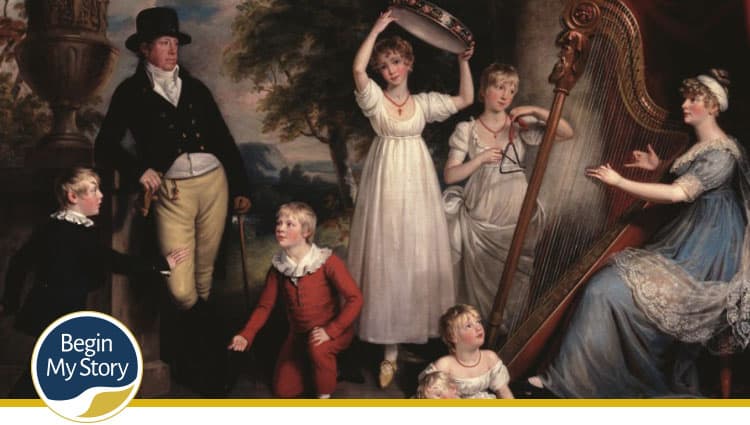
In the 1810 US Population Census, learn the approximate corresponding birth years associated with the age groupings provided. This census allowed 10 months to be completed. The first family would have been recorded on August 6, 1810, and the last family on June 6, 1811. The age groupings were for “For Free White Males and Females.” There are columns for all other free persons and slaves to be counted. Numbers shown in the age categories include all persons in the home, such as family, relatives, friends, employees, visitors, and boarders.
Note: No matter when the census taker came, he recorded who was in the house as of August 6, 1810. If a child was born after this date, they were not to be counted. If a person died before this date, they were not to be counted. It is very probable the census taker just recorded who was in the home the day he arrived. For more information, see the following article: How to Use the Census to Calculate the Birth Year
Age calculated as of August 6, 1820, and does not allow for the 10-month variance.
| 1810 U.S. Census Birth Year Reference Chart | |
| Age Category | Born Between Years |
| 10 & under (0-9) | 1800-1810 |
| 10 & under 16 (10-15) | 1795-1800 |
| 16 & under 25 (16-18) | 1794-1785 |
| 26 & under 45 (26-44) | 1784-1766 |
| 45 & up (45+) | 1765 and Before |
What is the 1810 U.S. Federal Census?
A census is a government-sponsored enumeration of the population in a particular area. It contains a variety of information — names, heads of household (or all household members), ages, citizenship status, ethnic background, and so on. Here are some different types of census records you are likely to come across in your research.
U.S. federal census is also called a population schedule. Federal census records provide the building blocks of your research, allowing you to confirm the information and learn more. Compiled in the United States for every decade since 1790, census population schedules are comprehensive, detailed records of the federal government’s decennial survey of American households. The federal government uses information from the schedules for demographic analysis.
The schedules themselves, of interest primarily to genealogists, contain the personal information of the survey respondents. To protect the people’s privacy whose names appear in each schedule, census records are restricted for 72 years after the census is taken and are not available to researchers during that time.
What Can You Find in U.S. Census
Use the 1810 U.S. Census Guide to learn about and discover the stories of the people who lived during and before the 1810s. The 1810 U.S. census only provides the name of the head of household and counts of persons in the home when the census was taken. With the 1810 U.S. census information, you can, for starters, build individual and family profiles, write narratives, build family trees and find related records to research. For example, you can use the census to:
- Follow the family beyond/before1850 census
- Identify head of household
- Estimate family structure such as the number of persons by age and sex
- Differentiate between families of the same name
- Locate and identify possible children not listed in later censuses
- Locate and identify possible neighbors who might be family
- Locate and identify possible parents
- Locate and identify children not yet known
- Locate and identify a family who are neighbors
- Identify slaveholders
- Identify spelling variations
- Follow the family before the 1810 U.S. Census into Colonial records
- Locate and identify a family in other census substitute records (e.g., probate inventories, tax lists)
Remember that the 1810 U.S. census by itself is limited. Still, when combined with other censuses and records, you now have a body of information and knowledge that can give a good overview of the family.
Questions Asked in the 1810 U.S. Census
The following are the questions found on the 1810 U.S. federal census:
HEAD OF HOUSEHOLD DATA
Col. 1: Name of Town, City, County or Village
Col. 2: Names of the Heads of Families
Col. 3: (Line name is recorded on)
HOUSEHOLD DATA—FREE WHITE MALES
Col. 4: (Number of) Under ten years of age to 10 (0-9)
Col. 5: (Number of) Of ten years, and under sixteen (10-15)
Col. 6: (Number of) Of sixteen, and under twenty-six, includes heads of families (16-25)
Col. 7: (Number of) Of twenty-six, and under forty-five, including heads of families (26-44)
Col. 8: (Number of) Of forty-five and upwards, including heads of families (45+)
HOUSEHOLD DATA—FREE WHITE FEMALES
Col. 9: (Number of) Under ten years of age to 10 (0-9)
Col. 10: (Number of) Of ten years, and under sixteen (10-15)
Col. 11: (Number of) Of sixteen years, and under twenty-six, includes heads of families (16-25)
Col. 12: (Number of) Of twenty-six, and under forty-five, including heads of families (26-44)
Col. 13: (Number of) Of forty-five and upwards, including heads of families (45+)
HOUSEHOLD DATA—ALL OTHERS
Col. 14: (Number of) All other free persons, except Indians, not taxed
Col. 15: (Number of) Slaves
OTHER
Col. 16: Total
Col. 17: (No. of the page where this was recorded)
Col. 18: Remarks
Author B. Schreiber’s Introduction to the U.S. Census
I first used the U.S. census to help find and discover the past of my step-father, John. I was interested in writing a personal narrative about his life. I wanted to answer questions like.
- Where was he born?
- Who was his family?
- What was his family story?
- What was it like during different periods of his life?
- Are there any family records (e.g., birth, marriage, school, death, etc.) that exist?
- Are there any photos, journals, letters, memorabilia about the individual or family?
- Are there living families or descendants that I can interview or help tell the story?
I did not have much information. I knew where he was buried. He was born in either the 1920s/1930s. He was born in one of four states, New Jersey, New York, Connecticut, or Pennsylvania. John had been married to my mother for about 5 years. After their divorce, my mother lost track of him until she received a call from the police department one day asking if she knew John. John’s body had been left in a hospital’s emergency room parking lot without any personal identification. His body was taken to a local morgue, where he remained for four months until he was identified by my mother. My mother then took steps to have John’s remains buried in a nearby cemetery with a military headstone.
I shared the story with a friend of mine who was a genealogist/family historian. She asked me if I had ever thought of looking in the U.S. Census. I responded with the answer of no and questioned her about how the c
She invited me to join her at a local library, where over the next couple of hours, she began to show me the census of the 1940s, 1930s, and 1920s. Within a couple of hours, she helped me find John and his related family in and around Jersey City, New Jersey. From those humble beginnings, I used the census as a steppingstone to finding records, locating living members of John’s family, and so much more.
In short, John was born in the late 1920s in Jersey City. Growing up, he became a bookie for the mob when he was in his early 20s. When he was caught stealing from the mob, the mob put out a contract on his life.
Desperately needing help, John went to his brother, a captain for the local police department, for safety. His brother was able to work directly with the mob to negotiate for Johns’s life. John was required to pay the money back with interest and leave town, never to return. He was a soldier in WWII and was wounded in the Battle of the Bulge. When he met my mom, he was a dispatcher for a taxicab company.
From that first experience, I spent 1000s hours learning how to use the U.S. 1940-1790 Censuses as a primary resource for my narrative and background research about individuals, families, and character development.






